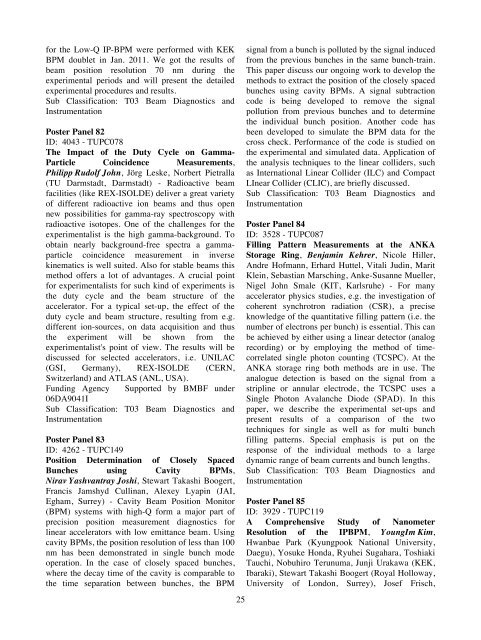Abstracts Brochure - 2nd International Particle Accelerator Conference
Abstracts Brochure - 2nd International Particle Accelerator Conference
Abstracts Brochure - 2nd International Particle Accelerator Conference
You also want an ePaper? Increase the reach of your titles
YUMPU automatically turns print PDFs into web optimized ePapers that Google loves.
for the Low-Q IP-BPM were performed with KEK<br />
BPM doublet in Jan. 2011. We got the results of<br />
beam position resolution 70 nm during the<br />
experimental periods and will present the detailed<br />
experimental procedures and results.<br />
Sub Classification: T03 Beam Diagnostics and<br />
Instrumentation<br />
Poster Panel 82<br />
ID: 4043 - TUPC078<br />
The Impact of the Duty Cycle on Gamma-<br />
<strong>Particle</strong> Coincidence Measurements,<br />
Philipp Rudolf John, Jörg Leske, Norbert Pietralla<br />
(TU Darmstadt, Darmstadt) - Radioactive beam<br />
facilities (like REX-ISOLDE) deliver a great variety<br />
of different radioactive ion beams and thus open<br />
new possibilities for gamma-ray spectroscopy with<br />
radioactive isotopes. One of the challenges for the<br />
experimentalist is the high gamma-background. To<br />
obtain nearly background-free spectra a gammaparticle<br />
coincidence measurement in inverse<br />
kinematics is well suited. Also for stable beams this<br />
method offers a lot of advantages. A crucial point<br />
for experimentalists for such kind of experiments is<br />
the duty cycle and the beam structure of the<br />
accelerator. For a typical set-up, the effect of the<br />
duty cycle and beam structure, resulting from e.g.<br />
different ion-sources, on data acquisition and thus<br />
the experiment will be shown from the<br />
experimentalist's point of view. The results will be<br />
discussed for selected accelerators, i.e. UNILAC<br />
(GSI, Germany), REX-ISOLDE (CERN,<br />
Switzerland) and ATLAS (ANL, USA).<br />
Funding Agency Supported by BMBF under<br />
06DA9041I<br />
Sub Classification: T03 Beam Diagnostics and<br />
Instrumentation<br />
Poster Panel 83<br />
ID: 4262 - TUPC149<br />
Position Determination of Closely Spaced<br />
Bunches using Cavity BPMs,<br />
Nirav Yashvantray Joshi, Stewart Takashi Boogert,<br />
Francis Jamshyd Cullinan, Alexey Lyapin (JAI,<br />
Egham, Surrey) - Cavity Beam Position Monitor<br />
(BPM) systems with high-Q form a major part of<br />
precision position measurement diagnostics for<br />
linear accelerators with low emittance beam. Using<br />
cavity BPMs, the position resolution of less than 100<br />
nm has been demonstrated in single bunch mode<br />
operation. In the case of closely spaced bunches,<br />
where the decay time of the cavity is comparable to<br />
the time separation between bunches, the BPM<br />
�<br />
25<br />
signal from a bunch is polluted by the signal induced<br />
from the previous bunches in the same bunch-train.<br />
This paper discuss our ongoing work to develop the<br />
methods to extract the position of the closely spaced<br />
bunches using cavity BPMs. A signal subtraction<br />
code is being developed to remove the signal<br />
pollution from previous bunches and to determine<br />
the individual bunch position. Another code has<br />
been developed to simulate the BPM data for the<br />
cross check. Performance of the code is studied on<br />
the experimental and simulated data. Application of<br />
the analysis techniques to the linear colliders, such<br />
as <strong>International</strong> Linear Collider (ILC) and Compact<br />
LInear Collider (CLIC), are briefly discussed.<br />
Sub Classification: T03 Beam Diagnostics and<br />
Instrumentation<br />
Poster Panel 84<br />
ID: 3528 - TUPC087<br />
Filling Pattern Measurements at the ANKA<br />
Storage Ring, Benjamin Kehrer, Nicole Hiller,<br />
Andre Hofmann, Erhard Huttel, Vitali Judin, Marit<br />
Klein, Sebastian Marsching, Anke-Susanne Mueller,<br />
Nigel John Smale (KIT, Karlsruhe) - For many<br />
accelerator physics studies, e.g. the investigation of<br />
coherent synchrotron radiation (CSR), a precise<br />
knowledge of the quantitative filling pattern (i.e. the<br />
number of electrons per bunch) is essential. This can<br />
be achieved by either using a linear detector (analog<br />
recording) or by employing the method of timecorrelated<br />
single photon counting (TCSPC). At the<br />
ANKA storage ring both methods are in use. The<br />
analogue detection is based on the signal from a<br />
stripline or annular electrode, the TCSPC uses a<br />
Single Photon Avalanche Diode (SPAD). In this<br />
paper, we describe the experimental set-ups and<br />
present results of a comparison of the two<br />
techniques for single as well as for multi bunch<br />
filling patterns. Special emphasis is put on the<br />
response of the individual methods to a large<br />
dynamic range of beam currents and bunch lengths.<br />
Sub Classification: T03 Beam Diagnostics and<br />
Instrumentation<br />
Poster Panel 85<br />
ID: 3929 - TUPC119<br />
A Comprehensive Study of Nanometer<br />
Resolution of the IPBPM, YoungIm Kim,<br />
Hwanbae Park (Kyungpook National University,<br />
Daegu), Yosuke Honda, Ryuhei Sugahara, Toshiaki<br />
Tauchi, Nobuhiro Terunuma, Junji Urakawa (KEK,<br />
Ibaraki), Stewart Takashi Boogert (Royal Holloway,<br />
University of London, Surrey), Josef Frisch,


